Mobile GPU Faceoff: AMD Dynamic Switchable Graphics vs. NVIDIA Optimus Technology
by Jarred Walton on September 20, 2011 6:40 AM ESTMedium Detail Gaming Comparison
We’re going to focus on the main gaming target for this level of hardware: our Medium presets. The Low preset tends to look pretty lousy in several of the games (StarCraft II being the worst), while our High settings are too much for the GT 540M/HD 6630M in about half of the titles, even at 1366x768. Medium detail on the other hand should give us 30+ FPS in nearly all of the games we’re testing while still providing decent visuals. Here are the results.
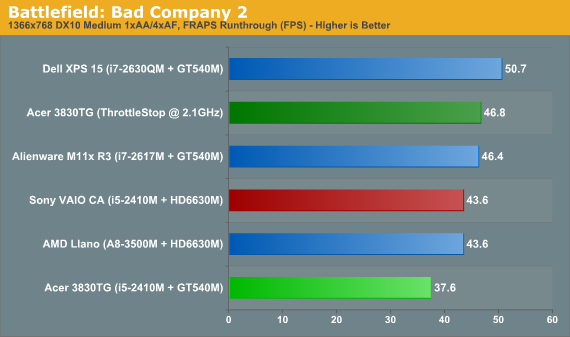

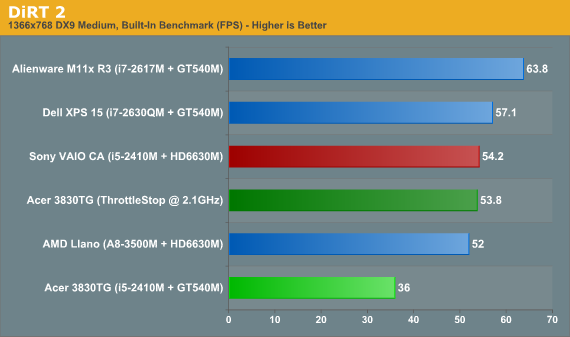
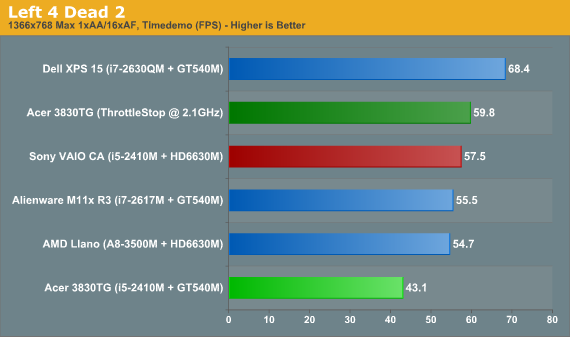
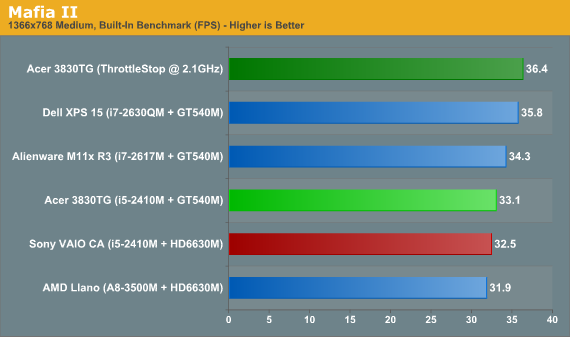


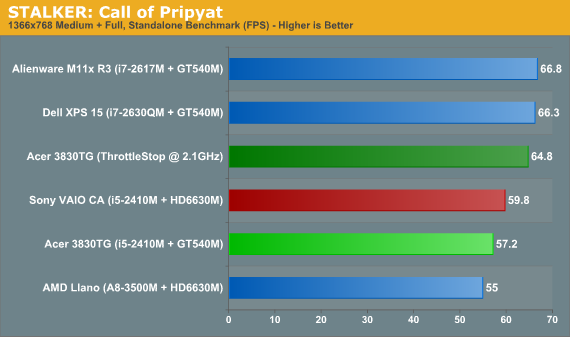
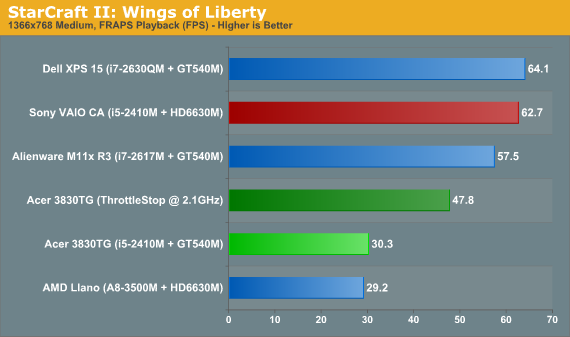
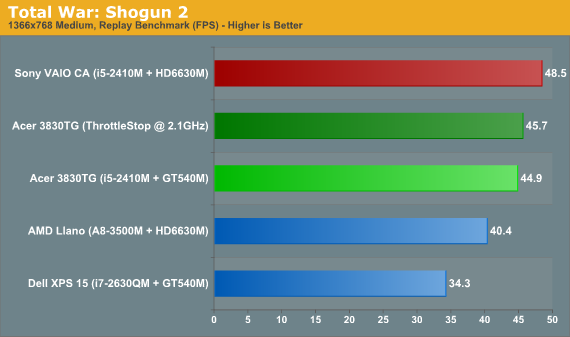
In terms of performance, the 6630M matches up nicely against the GT 540M. It wins a few games by a small margin, loses a few by a similarly small margin, and ties in the remainder. If we were just looking at gaming performance, there’s not much to discuss here. NVIDIA still has CUDA and PhysX, and AMD has their Accelerated Parallel Processing SDK, but given the level of performance we’re talking about, you won’t need or use these extras most of the time. Unfortunately for AMD, it’s not just about gaming performance.
We tested ten games (though we don’t have results from the Alienware M11x R3 in Civilization V and Total War: Shogun 2), and the newest titles are Civ5 (13 months old) and TWS2 (6 months old). You’d hope that with relatively known games, compatibility wouldn’t be an issue, but we ran into two problems during testing.
The first wasn’t a consistent problem, but we did have a couple of crash to desktop issues when benchmarking DiRT 2 using Dynamic Switchable Graphics mode. The other issue was a lot worse, and it was in StarCraft II when running at anything more than the Low default settings. As noted earlier, SC2 looks pretty lousy at its minimum settings, and Medium detail (and possibly even High) should be more than playable on the HD 6630M. In dynamic mode, however, not only was performance quite a bit lower than expected at our Low settings, but at Medium and above there were tons of missing textures. The solution is to switch to manually controlled switching, which solved both the performance and rendering errors, but then why even have dynamic switching in the first place?
While we’re on the subject, let’s also take a look at a few other comparisons. Running “stock” on the CPU, the Acer 3830TG is slightly slower overall than when using ThrottleStop to limit the CPU to 2.1GHz. With ThrottleStop, the average score across ten games improves by 20%, so the CPU throttling has a major impact in games. Civ5, ME2, and TWS2 show the least difference, with Mass Effect 2 being the only game that ran slightly faster at the stock CPU settings; Mafia 2 runs 10% faster, Metro 2033 and STALKRE are 13% faster, L4D2 jumps up 28%, DiRT2 is 49% faster, and the ever-CPU-limited StarCraft II runs 58% faster. Interesting to point out is that 2.1GHz is 75% higher than 1.2GHz, so on average it looks like the 3830TG runs around 1.3GHz in StarCraft II.
Flipping over to the other GT 540M equipped laptops and using the best result from the Acer 3830TG, the Alienware M11x R3 averages out to 3.5% faster, but it only has a clear lead in two games (DiRT2 and SC2) while it’s slightly slower in L4D2 and Mafia2. The Dell XPS 15 comes in 9% faster than the 3830TG on average, with the biggest lead again coming from SC2; Mafia2 once again gives the 3830TG a lead, so the latest NVIDIA drivers appear to be playing a role.
Finally, since we now have results from the HD 6630M with a Llano A8-3500M as well as the i5-2410M, we thought it would be interesting to see just how much performance you give up by gaming with the slower Llano CPU. If you’ll recall, in our first look at a Llano notebook, we expressed concern that the CPU would hold back GPU performance. Out of our ten tested titles, only Mass Effect 2 ran faster on Llano with a dGPU. Most games (at Medium settings where the GPU becomes more of a bottleneck) are close: BFBC2 and Civ5 are exactly the same performance, Mafia 2 is 2% faster with the Intel CPU, and Dirt2, L4D2, Metro, and STALKER are all within 5-10%. Not surprisingly, StarCraft II is the big outlier, running over twice as fast on the Intel i5-2410M. We’re still not looking at similar driver builds, as the Llano laptop is running a Catalyst 11.6 derivative (8.862.110607a-120249E) compared to 11.1 on the Sony, but even so the average performance increase with an Intel CPU comes in at 12% (mostly thanks to SC2).
Since there were two games where we didn’t have a perfect experience, we decided to look at some more recent titles.










91 Comments
View All Comments
Death666Angel - Wednesday, September 21, 2011 - link
"but then why even have dynamic switching in the first place?"That is a good question. I myself would prefer a solution that lets me decide what to do. I wouldn't prefer dynamic switching, because I want to be in control of my hardware as much as possible. Reboot switching is of course a pain in the butt, but I see nothing wrong with a short cut manual switch for iGPU/dGPU switching. Would be preferable to me actually.
But otherwise, thanks for the article.
mars2k - Wednesday, September 21, 2011 - link
I purchased a Lenovo W520 on the first day of release. Got the Thinkpad and could never get the graphics to perform correctly. Integration with the Intel board was lousy. Lenovo's support team could do nothing. I returned the machine. I'm thinking buggy drivers were the problem.My particular problem revolved around using multiple monitors. Connecting disconnecting or configuring multi monitors would often require a reboot. Worse than worthless!
Wolfpup - Wednesday, September 21, 2011 - link
“With all my talk of switchable graphics, though, let’s make one thing clear: switchable graphics is not necessarily the Holy Grail of mobile GPUs. The true ideal in my opinion is mobile GPUs that can run fast when needed (i.e. playing games), while also being able to power off large portions of the chip and RAM and get down to IGP levels of power consumption.”THANK you for that! That's the first time I've heard that said since all this switchable graphics stuff started.
As far as I'm concerned, the GPU situation on notebooks is a disaster, and right when I thought we were finally moving in the first direction, this switchable stuff came out.
As it is now, a HUGE percent of notebooks can't use Nvidia or AMD's normal drivers. Sandy Bridge + AMD shouldn't even be on the market, and shouldn't be considered by anyone. As the article mentions-you can't use normal drivers for those, at least not today. (AMD + AMD should work sooner or later, although the A series CPUs aren't listed yet in the driver download box on AMD.com...my little c50 notebook is supported though, so hopefully the A stuff will be soon too.)
I just bought Asus' G74, which I've really liked-and one of the reasons I bought it was that it DOESN'T use switchable graphics, and it DOES use normal drivers from Nvidia. Some more expensive systems with even better GPUs can't use the normal drivers, which IMO just isn't acceptable in a $1000 purchase, let alone a $2000+ purchase.
At any rate, Nvidia's current GPUs underclock themselves to a very impressive 50mhz, several times slower even than my Geforce 9650GT from 3 years back. As mentioned, get power gating in there, and just get rid of Optimus and AMD's equivalent. Get rid of that complexity, driver/compatibility weirdness, etc.
Even once switchable graphics are gone, we're STILL not there yet...as the article mentions, most of Sony and Toshiba's notebooks can't be updated. Sager's stuff apparently can't, etc.
My Asus N80 from 3 years ago and my G74 both accept Nvidia.com driver updates just like a desktop system, no hacks, nothing weird, it just works. And that's how it should be!
Anato - Friday, September 23, 2011 - link
Shouldn't be too difficult to make GPU which can divide resources so that parts of the unit can be shut down. Even CPU's can do that and they are executing same code as compared to GPU which can be more liberal on architecture.JonnyDough - Friday, September 23, 2011 - link
"If nothing else, Sony at least knows how to tune their laptops for long battery life."Now if they can just make PS3 networking that isn't so hackable, batteries that don't explode, and Blu-Ray discs that don't cost 4X as much as an up-scalable DVD. At least they are smart enough to partner up with AMD.
pman6 - Friday, September 23, 2011 - link
AMD's solution definitely seems half assed. Their drivers are always crap....just like how they rolled out the mobile llano hybrid crossfire with crap performance.
seems like they can never get the drivers right.
I have a llano laptop with crossfire, and you would think they would be able to do split frame rendering to improve performance. but 99% of the time, crossfire game performance is worse than discrete alone.
AMD needs to get their crap together.
netkcid - Friday, September 23, 2011 - link
good job trying to switch and run dx11 apps on a dx10 igp... and then complain about it...durJarredWalton - Saturday, September 24, 2011 - link
All of the games should run on the Intel IGP; none of them are DX11 only. Double dur. The point is that they're not switching over to the IGP when the laptop is set to do so. But that's not really the major issue -- if you're running a game, you'll want it on the dGPU 99% of the time. The real issue is that the dynamic switching failed to work properly. When the competition can make it work properly, and when your non-dynamic generally can work properly, then your drivers are not finished and certainly not worthy of WHQL certification (which has apparently become a joke these days).medi01 - Sunday, September 25, 2011 - link
"Before we get to the actual meat of this review, we have a disclaimer to make: both laptops we’re comparing came to us via NVIDIA. Now, before anyone cries “foul!”, let me explain..."Let me explain: AMD not sending you whatever you want is not a good enough reason to do hidden ads for nVidia.
JarredWalton - Tuesday, September 27, 2011 - link
Thanks for speaking for AMD, but I talked to them over four times throughout the course of this review. I've had this hardware since July, if that helps you figure out how much I've been waiting for AMD to step up with something better. In effect, I told AMD when I first got the laptop, "Look guys, I've got a Sony VAIO C with Intel + AMD dynamic switchable graphics, and there are problems. There are also no recent drivers. This review won't be favorable toward your solution if you can't get me something better." If I had given them a week, or even two, sure, but two months is more than enough time to give me something better if such a thing exists.Sticking up for AMD's solution just because it's from AMD is not a reason enough to do so. The solution as it currently stands is broken. It can be fixed, but until it actually IS fixed, I cannot recommend buying it. Like I said, I'd rather have AMD discrete GPU without switchable graphics on a laptop, because then at least I can get driver updates. And if you don't need driver updates, you don't really need a discrete GPU in your laptop.